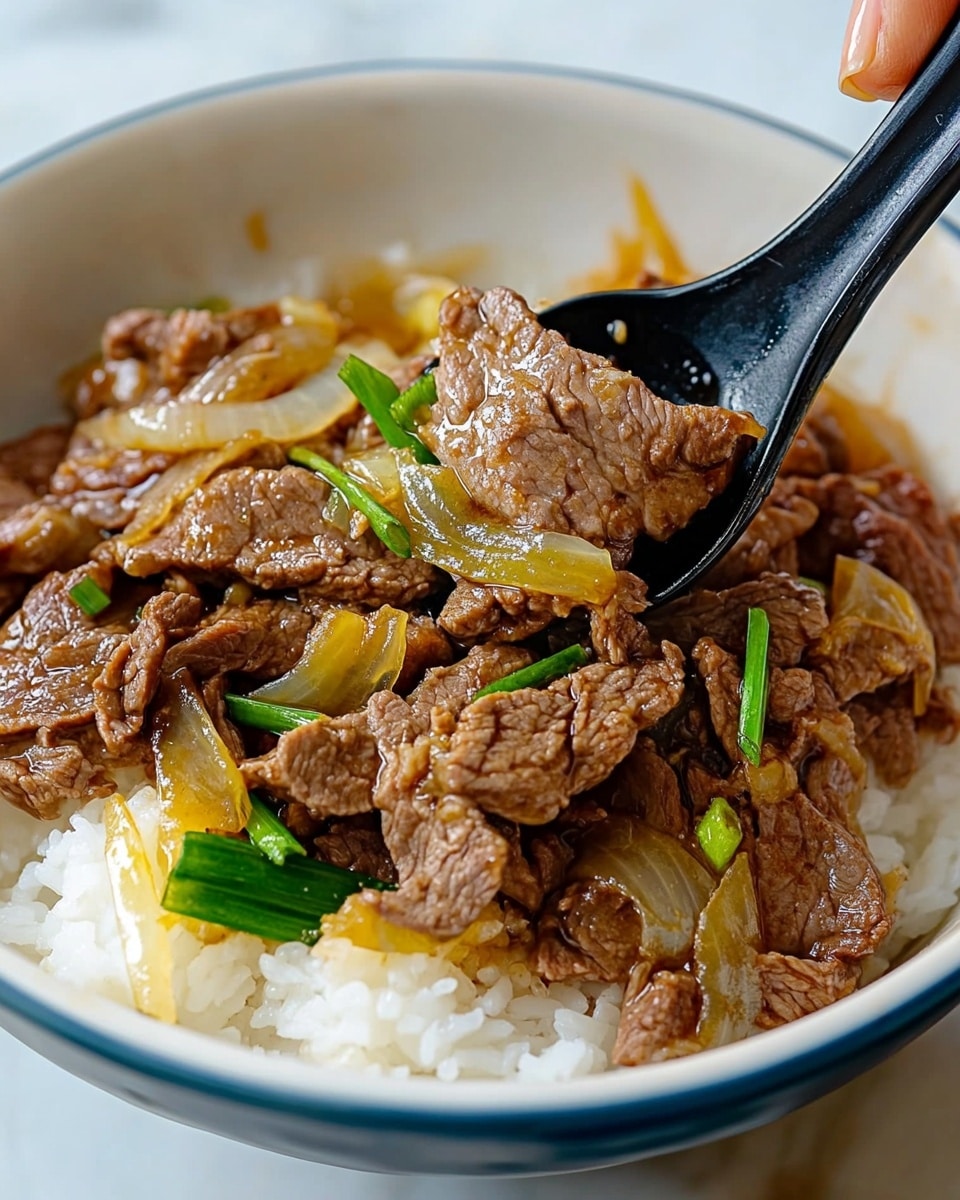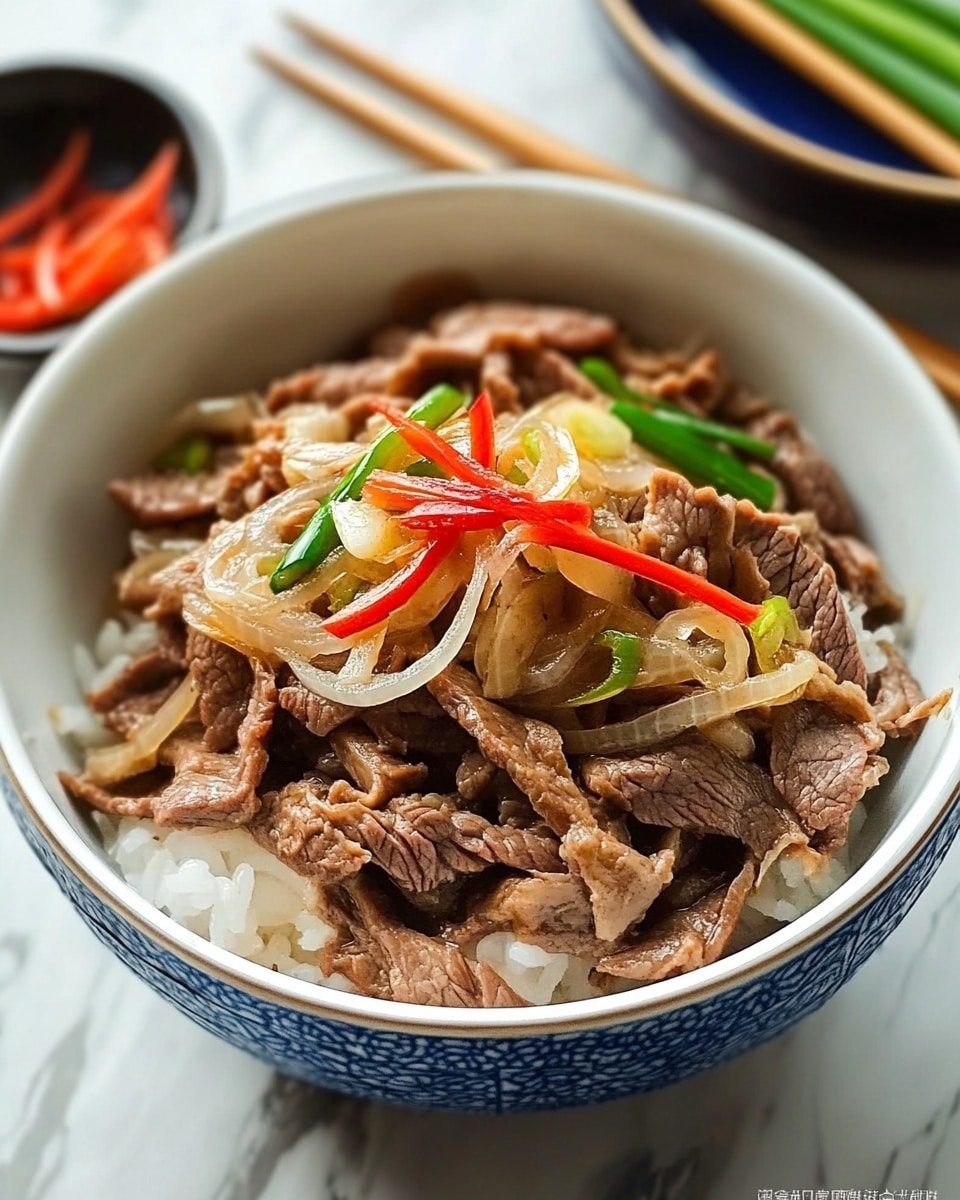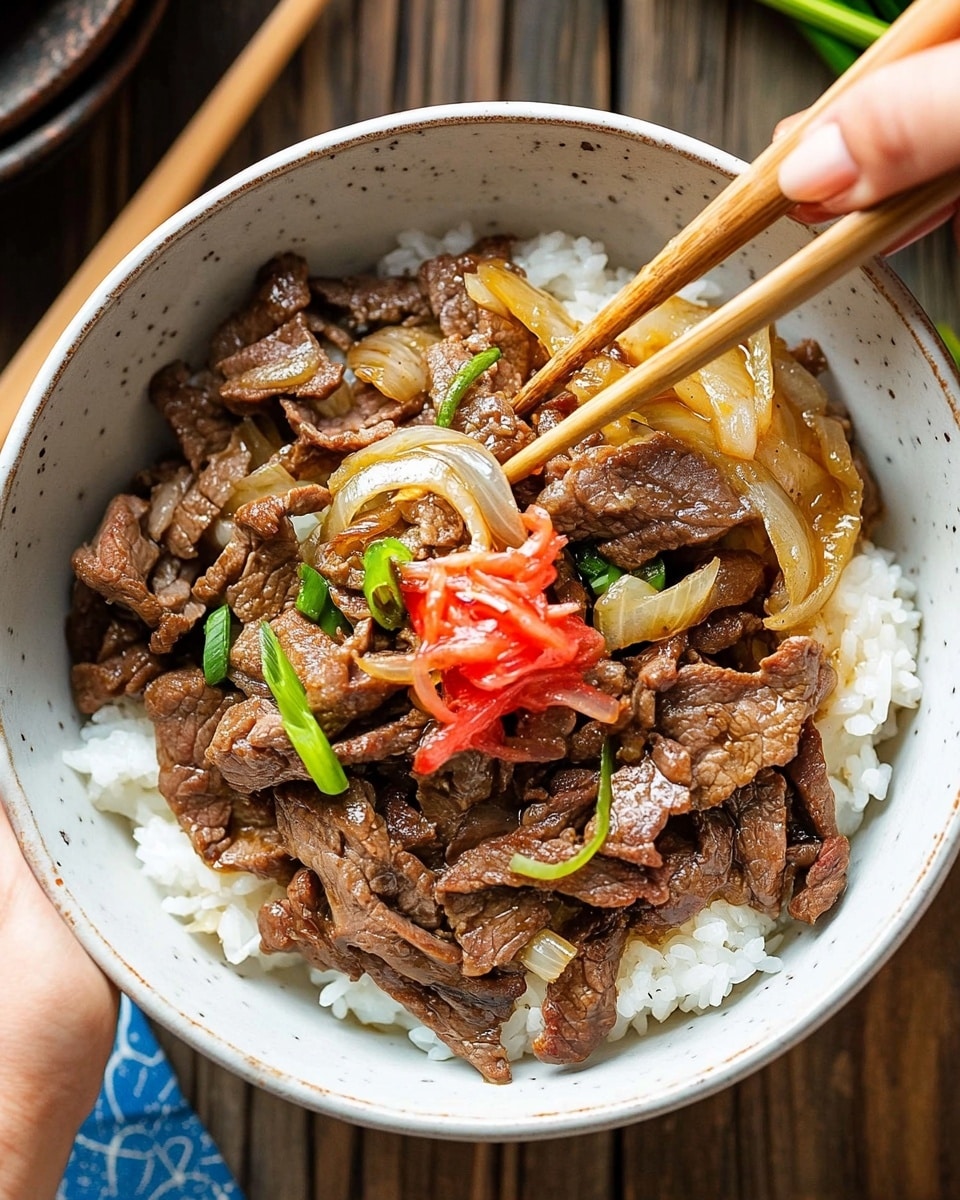I absolutely love this Gyudon (Japanese Beef Rice Bowl) Recipe because it brings the comforting flavors of Japan right into your own kitchen. It’s quick to prepare, packed with savory goodness, and perfect for any night when you want a satisfying meal without too much fuss. You’ll find that the blend of tender beef, sweet and salty broth, and fluffy rice makes this one of the most comforting bowls you can enjoy.
When I first tried making Gyudon at home, I was amazed at how simple the ingredients are, yet how rich the flavors turn out. This recipe shines on busy weekdays but is also special enough to share with family or friends. Plus, once you get the hang of it, you’ll find yourself coming back to it again and again as a go-to, crowd-pleasing favorite.
Why You’ll Love This Recipe
- Simple Ingredients: You don’t need a long shopping list to make this authentic and delicious dish.
- Fast and Easy: It comes together quickly, making it perfect for busy weeknight dinners or last-minute meals.
- Authentic Flavor: Using dashi and mirin brings the deep umami that makes Gyudon so irresistible.
- Versatility: You can customize it with eggs, pickles, or veggies, making it your own comfort bowl.
Ingredients You’ll Need
The ingredients for this Gyudon (Japanese Beef Rice Bowl) Recipe blend classic Japanese flavors with fresh elements that come together beautifully. It’s all about balance here – a little sweetness, a little saltiness, and that rich, comforting beef that’s cooked just right.
- Onion: Thinly sliced, it softens and sweetens as it simmers in the sauce.
- Green onion/scallion: Adds a fresh pop of flavor and color when sprinkled on top.
- Thinly sliced beef (ribeye preferred): Semi-frozen for easy slicing, it cooks quickly and stays tender.
- Dashi (Japanese soup stock): This brings the essential umami base to the sauce; you can use powder or packets handy from Asian markets.
- Sake: Adds depth and a little sweetness; sub with dry sherry or rice wine if needed.
- Mirin: A sweet Japanese cooking wine that balances savory flavors perfectly.
- Soy sauce: For salty, savory richness.
- Sugar: Just enough to bring everything together in perfect harmony.
- Cooked Japanese short-grain rice: Sticky and fluffy—necessary for that authentic donburi experience.
- Pickled red ginger (beni shoga): This bright garnish cuts through the richness and adds a delightful zing.
Variations
I love to mix things up depending on what’s in my fridge or the season. Feel free to make this Gyudon (Japanese Beef Rice Bowl) Recipe your own with a few tweaks that suit your taste or dietary needs.
- Add a Soft-Poached Egg: I usually top the bowl with an onsen tamago or just a soft poached egg for extra creaminess—my family goes crazy for that!
- Vegetarian Version: Swap beef for thinly sliced mushrooms or tofu and use vegan dashi to keep those umami flavors vibrant.
- Spicy Kick: Adding a little chili oil or togarashi flakes gives a nice warmth that wakes up the dish.
- Extra Veggies: Try adding shredded carrots, bok choy, or spinach for a nutrient boost and color pop.
How to Make Gyudon (Japanese Beef Rice Bowl) Recipe
Step 1: Prep Your Ingredients Like a Pro
Start by slicing half an onion thinly—this helps it cook evenly and sweeten up nicely in the sauce. Then, slice your green onion diagonally into thin pieces to preserve that subtle crunch and bright flavor as a finishing touch. If you’re buying beef already thinly sliced (ribeye works beautifully), pop it into the freezer for about 10 minutes — this semi-freeze trick makes it so much easier to cut the beef into neat, 3-inch long strips without it getting mushy.
Step 2: Make the Sauce and Layer the Ingredients
In a large frying pan (don’t heat it on yet!), combine ½ cup dashi, 2 tablespoons sake, 2 tablespoons mirin, 3 tablespoons soy sauce, and 1 tablespoon sugar. Give the mixture a good stir to dissolve the sugar thoroughly. Then lay your onion slices evenly in the broth throughout the pan, separating the layers so each piece bathes in that flavorful liquid. Next, arrange the beef strips over the onions, separating each piece to cover the pan evenly — this helps the meat cook thoroughly and absorb sauce.
Step 3: Cook With Care
Cover the pan with a lid, then turn the heat to medium. Once it comes to a gentle simmer, lower the heat to continue cooking covered for 3 to 4 minutes. This step is key: it allows the beef to become tender and soak in the rich sauce while the onions soften perfectly. While it simmers, peek occasionally to skim off any scum or excess fat with a fine mesh skimmer—that little trick keeps your broth looking and tasting clean. Finally, sprinkle the green onions on top, cover again, and let it cook for just another minute to freshen up the flavors.
Step 4: Serving Time!
Spoon your steamed Japanese short-grain rice into bowls—fluffy and sticky rice is crucial here for that authentic donburi experience. Drizzle some of the flavorful pan sauce over the rice, then pile on the beef and onions. If you have leftover sauce, go ahead and brush a bit more on top. Finish it off with a handful of pickled red ginger—it adds that bright, tangy bite that contrasts beautifully with the rich beef. Now, dig in and enjoy!
Pro Tips for Making Gyudon (Japanese Beef Rice Bowl) Recipe
- Freeze the Beef Slightly: I always freeze my beef for about 10 minutes before slicing—it’s way easier to get nice thin, even strips this way.
- Don’t Rush the Simmer: Lowering the heat once simmering starts keeps the meat tender and prevents it from drying out.
- Skim the Foam: Removing scum while cooking gives you a cleaner broth—this little step makes a big difference in presentation and taste.
- Keep the Rice Warm: Serving with freshly steamed rice ensures the perfect texture and temperature for your Gyudon every time.
How to Serve Gyudon (Japanese Beef Rice Bowl) Recipe

Garnishes
For me, the classic pickled red ginger (beni shoga) is a must—it cuts through the richness with its tangy zing and adds a beautiful pop of color. I also love sprinkling freshly chopped green onions on top for freshness and crunch. Some days, I like to add a soft-cooked egg or a drizzle of Japanese mayo for extra creaminess that’s simply divine.
Side Dishes
Gyudon goes well with light sides like a simple miso soup or a crisp cucumber salad. Sometimes I serve it alongside steamed edamame or pickled vegetables for a nice contrast. You’ll find that these lighter sides balance the rich, savory beef bowl perfectly.
Creative Ways to Present
For a fun twist, try serving Gyudon in individual donburi bowls with small side plates of pickles and a bowl of soup for a complete Japanese-themed meal. If you’re hosting a casual dinner, set out toppings like sliced green onions, chili oil, and additional pickled ginger so guests can customize their own bowls. It’s always a hit and makes dinner feel festive!
Make Ahead and Storage
Storing Leftovers
Any leftover beef and sauce mixture can be stored in an airtight container in the refrigerator for 2 to 3 days. I like to keep it separate from the rice to avoid sogginess. When you’re ready to eat again, warm the beef gently on the stovetop or microwave and serve freshly cooked rice alongside.
Freezing
I’ve frozen leftover Gyudon successfully up to 3 or 4 weeks by packing the beef and sauce in freezer-safe containers. Just thaw it overnight in the fridge before reheating for best texture. The flavors hold up well, making it great for a quick meal down the line.
Reheating
To reheat, I prefer warming the beef mixture gently in a pan over low heat, adding a splash of water or dashi if it seems dry. This helps maintain moisture and flavor. Serve immediately over freshly steamed rice for the best experience—trust me, it tastes almost as good as fresh!
FAQs
-
Can I use a different cut of beef for this Gyudon recipe?
Absolutely! Ribeye is preferred for its tenderness and marbling, but you can use other thinly sliced cuts like sirloin or chuck. Just make sure they’re sliced thinly so they cook quickly and stay tender.
-
What if I don’t have dashi—is there a substitute?
If you don’t have dashi, you can use a good quality chicken or vegetable broth as a substitute, though it won’t have the same umami depth. There are also instant dashi powders easily found online or in Asian grocery stores that work great and add authentic flavor.
-
Can I make this recipe without alcohol?
Yes! You can substitute sake with water or use a little extra mirin with sugar to keep a balanced sweetness. The alcohol cooks off anyway during simmering, so the flavor is subtle but important—adjust to your preference.
-
How do I store and reheat leftover Gyudon safely?
Store leftovers in an airtight container in the fridge for up to 3 days or freeze for up to a month. Reheat gently on low heat, adding a splash of water if needed to keep the beef juicy, and serve over freshly steamed rice for best results.
Final Thoughts
This Gyudon (Japanese Beef Rice Bowl) Recipe holds a special place in my heart because it’s both simple and incredibly satisfying. Whether you’re new to Japanese cooking or looking to perfect a comforting classic, you’ll enjoy how the flavors come together with minimal effort. I hope you give this recipe a try—it’s like a warm hug in a bowl that you can make anytime you want a little taste of home.
Print
Gyudon (Japanese Beef Rice Bowl) Recipe
- Prep Time: 5 minutes
- Cook Time: 15 minutes
- Total Time: 20 minutes
- Yield: 2 servings 1x
- Category: Main Dish
- Method: Stovetop
- Cuisine: Japanese
Description
Gyudon is a classic Japanese beef rice bowl that features thinly sliced beef and onions simmered in a savory and slightly sweet dashi-based sauce, served over steamed Japanese short-grain rice. This comforting dish is quick to prepare and brings the authentic flavors of Japan to your table, garnished with pickled red ginger for a refreshing contrast.
Ingredients
Beef and Vegetables
- 1/2 onion (4 oz, 113 g), thinly sliced
- 1 green onion/scallion, diagonally sliced
- 1/2 lb thinly sliced beef (such as ribeye), cut into 3-inch wide pieces
Sauce
- 1/2 cup dashi (Japanese soup stock; use Awase Dashi, dashi packet or powder, or Vegan Dashi)
- 2 Tbsp sake (or dry sherry, Chinese rice wine, or water for non-alcohol version)
- 2 Tbsp mirin (or 2 Tbsp sake/water + 2 tsp sugar)
- 3 Tbsp soy sauce
- 1 Tbsp sugar (adjust to taste)
For Serving
- 2 servings cooked Japanese short-grain rice (approximately 1 2/3 cups or 250 g per serving)
- Pickled red ginger (beni shoga or kizami beni shoga) for garnish
Instructions
- Prepare Ingredients: Thinly slice half an onion and diagonally slice the green onion. Slightly freeze the beef to firm it up for easier slicing, then cut into 3-inch wide pieces.
- Make Sauce Base: In a large frying pan (off heat), combine ½ cup dashi, 2 Tbsp sake, 2 Tbsp mirin, 3 Tbsp soy sauce, and 1 Tbsp sugar. Stir well until the sugar dissolves.
- Add Vegetables and Beef: Spread the sliced onions evenly in the sauce to separate the layers. Then distribute the sliced beef evenly on top, separating the slices so the meat covers the onions.
- Simmer: Cover the pan and turn the heat to medium. Once it starts simmering, reduce heat to low and cook covered for 3–4 minutes, allowing the flavors to meld and beef to cook through. Occasionally skim off any scum or fat from the surface using a fine-mesh skimmer.
- Add Green Onions and Finish Cooking: Sprinkle the sliced green onions over the simmering beef and onions. Cover and cook for another minute. Optionally, add beaten eggs at this step for a richer texture.
- Serve: Place two servings of cooked Japanese short-grain rice into donburi bowls. Drizzle some of the pan sauce over the rice, then top with the beef and onion mixture. Optionally drizzle more sauce on top and garnish with pickled red ginger. Enjoy!
- Storage: Store any leftovers in an airtight container in the refrigerator for 2–3 days or freeze for up to 3–4 weeks.
Notes
- For a Kansai-style variation, stir-fry onions with oil until tender first, add beef and sugar to combine, then add sake, mirin, and soy sauce, cooking until beef is no longer pink.
- Optionally drizzle beaten eggs slowly over the beef without mixing, add green onions on top, and cook covered until eggs are set.
- Use semi-frozen beef slices for easier and more uniform thin slicing.
- Adjust sugar in the sauce to your taste preference for sweetness.
- Pickled red ginger adds a bright, tangy contrast that complements the rich beef flavor.



